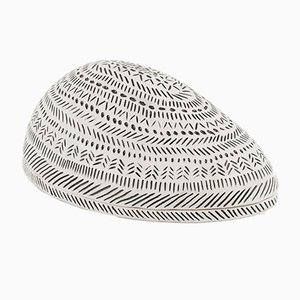The contemplative Skep series by Atelier KAS
Modern Meditations
While Budapest’s Atelier KAS launched only a few months ago—and the designer behind it is just in her twenties—it’s already quite clear there’s an old soul at work here. The studio’s debut project, a series of organically shaped clay vessels called Skep, is aesthetically quite simple, but takes its cues from an olio of weighty, even timeless notions: a faith in our ability to connect with one another across time and space, the honor inherent in methodical practice, and the essential virtues and lessons readily available (and often overlooked) in nature.
As designer Katalin Dóra Bartis tells us, “I think that pieces of art possess a certain kind of power. They will tell you what they are about if you look carefully. With Skep, I hope the series speaks to others of the importance of being close to nature: how we should study it, learn from it, try to understand it. If someone looks at these objects, maybe they don't get it exactly, but I believe a particular feeling comes across somehow.”
Skep feels at once accessible, familiar, and layered with some age-old knowledge. Which is just as Bartis intends. “I see my works as reminiscent of ancient artifacts and folk art pieces. I like objects with simple and meaningful designs that are in harmony with their owner. And I think it's becoming more and more important for people to fill their homes with pieces that are one-of-a-kind and have a story to tell.”
She goes on: “My aim is to bring back more personal design for home articles, as it was in earlier times in the villages of Hungary. You knew who made each piece and the meaning behind every decorative symbol. I don't use actual figurative symbols in my work, but the leading ideas and the abstract forms have a lot to say.”
Skep’s white exteriors are speckled with black cut-outs. The vessels’ interiors sport super saturated colors, a rich pop against the black and white. Their forms are inspired by objects found in nature and rural life—haystacks, beehives—as well as their namesake: the manmade, traditional woven baskets used as artificial beehives. “Both baskets made by man and beehives made by bees are created in a particular order thanks to careful, tedious work, and the results are absolutely ideal for their purposes. I am so amazed by the creatures of nature: they are perfect. And I really enjoy it when people try to do something similar with very simple, clever, and useful objects. That inspires me.”
In addition to nature and basketry, Bartis also cites Bronze Age ceramics as an influence. Though ultimately, she says, “It all goes back to nature. Because ancient art and folk art are very connected to it; just as people in earlier times were much closer to nature. What I really like are the elemental shapes, the geometric patterns. Because if you think about it, the forms of nature are full of geometry: leaves, branches, flowers, snowflakes, and on and on.”
Bartis makes each Skep piece by hand, using basic tools and simple, raw materials that she buys at the nearest ceramic supply shop. For each piece, she layers small slices of white clay one on top of the other; and then uses a flat, wooden tool to shape and smooth the surface of the clay. Afterwards, she uses a sharp tool to carve out patterns on the object’s surface—reminiscent of the patterns found in woven objects. She fires the clay, paints the small impressions with a black gaze, and then covers the entire piece in a transparent glaze to make it watertight and washable. According to Bartis, it takes her anywhere from four to seven hours per piece, depending on size and shape. She enjoys the methodical nature of her work: “The process is a bit meditative, but I think making art always should be so.” Plus, she says, “I like to spend time with my objects—to give them something of myself.”
The spirit behind her debut series is so integral to Bartis’s design philosophy, in fact, that she even named her studio for them: kas is the Hungarian word for skep. Beyond the more obvious notion of “home”—a skep being a home for bees, her pieces being created for use in homes—and the importance of connectivity and nature, she cites an additional layer of meaning. “Bees were the symbols of fertility in ancient times. This is important for me as both a creative and a woman: how to be feminine and ambitious at the same time today. It's a challenge, I think.”
For now, Bartis works at a big, wooden desk in her Budapest home—“as my tools are completely mobile, I can put everything away when I have to”—which she shares with her husband. She gave her very first Skep piece to him as a present: “Without him, I couldn’t have started KAS or gotten through the difficult moments. I am very grateful for him.” Someday, they hope perhaps to move into a larger space where she may have a dedicated studio.
And though she’s just getting started, Bartis’s vision for her atelier’s future is clear. “It is a great adventure for me to start a business, and I am very eager to see where it goes. I am grateful to have the opportunity to test myself like this. My goal with KAS is to create spirited, handmade objects. I’ve started with ceramics, but I plan to do jewelry, textiles, and furniture. And as I am an architect [by training and education], later on I plan to design homes in harmony with nature as well.”
-
Text by
-
Anna Carnick
Anna is Pamono’s Managing Editor. Her writing has appeared in several arts and culture publications, and she's edited over 20 books. Anna loves celebrating great artists, and seriously enjoys a good picnic.
-


